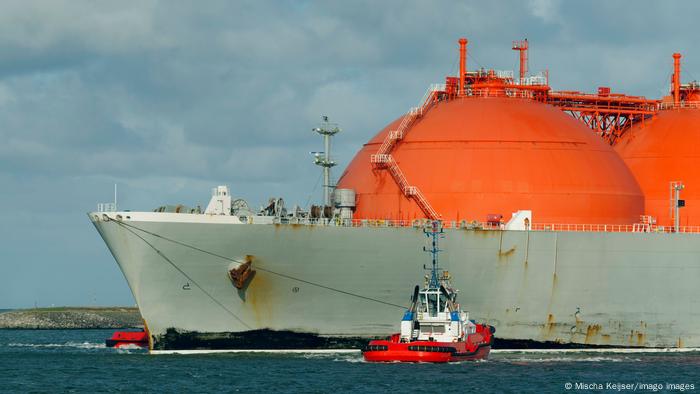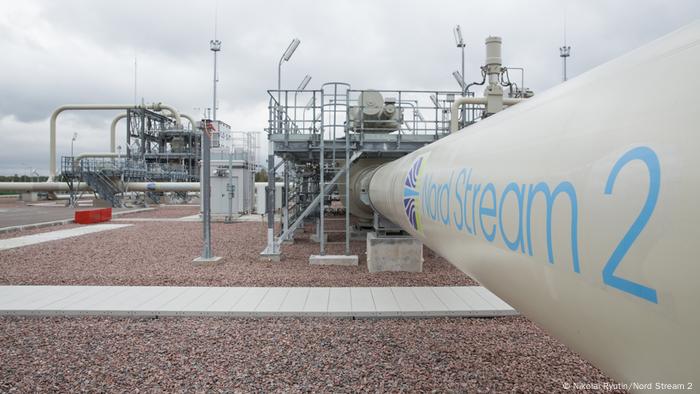Europe's gas reserves are at their lowest in years just as peak winter demand hits. If Russia were to halt gas deliveries over the Ukraine crisis, could liquefied natural gas (LNG) fill the gap?

Ships destined for Asia carrying liquified natural gas (LNG) have been rerouted to help ease Europe's energy crisis
The true scale of Europe's energy crisis hit home this week when Commerzbank published data showing the current stockpile of natural gas across the European Union.
The storage facilities of EU nations are less than half full — and that's at the height of peak winter demand, according to Germany's second-biggest lender.
"Current inventories are about 47% of full capacity," Bernd Weidensteiner, senior economist at Commerzbank in Frankfurt, told DW. "Normal for this time of the year is about 60% ... so we are significantly lower."
Indeed, a Commerzbank graphic posted to Twitter shows that, in previous years, EU inventories have ranged from 60% to more than 85% in January.
Europe was already struggling with an energy crunch when Russia's state-controlled Gazprom slashed natural gas deliveries to the bloc in October, sending soaring prices higher still.
Moscow, which supplies about 40% of Europe's imported gas, is accused of using its energy exports as leverage in a dispute over Ukraine, through which much of the Russian gas transits.
Russia is believed by the West to be planning a full-scale invasion of Ukraine, after the Kremlin amassed more than 100,000 troops at its border with the Eastern European country over the past two months.
Europe's energy security threatened
Just as German and US diplomats have warned Russian President Vladimir Putin against escalating the crisis, leaders on both sides of the Atlantic are growing anxious about the vulnerability of Europe's energy security.
If Putin were to cut off natural gas supplies during a military conflict or in retaliation for any future Western sanctions, Weidensteiner warned that "some [European] inventories might run extremely low."
To help ease demand for gas to heat and power homes and businesses, last month some 10 cargoes of liquefied natural gas (LNG) that were destined for Asia were diverted to Europe.
Could LNG fill the gap?
The move reignited the debate about whether LNG could be a more permanent solution to Europe's energy dependence on Russia.
LNG is a natural gas that is cooled down to liquid form and shrunk to 1/600th of its original volume. The liquid is often exported in huge ships containing heavily insulated tanks that keep the gas in a liquid state at approximately -162 Celsius. At the other end, the liquid is turned back into a gas (regasified).
The US has long warned of the threat posed by Russia's dominance in the natural gas sector, partly in an attempt to boost its LNG exports to Europe. Thanks to the shale gas boom of the past decade, the US is now the world's largest exporter of LNG.
But, while American energy firms are ramping up LNG export capacity by almost 20%, to 13.9 billion cubic feet per day by the end of the year, according to the International Energy Agency, the new supply won't be enough to bail out Europe if Putin turns off the taps.
LNG exporters need time
In the short term, "LNG would not be able to fully compensate [for any natural gas shortfall from Russia]," Weidensteiner said, citing "a lack of free short-term capacity among exporters like the US and Qatar."
The Commerzbank economist said that, though Europe still has the capacity to process or regasifiy the imported liquid gas, "it would be difficult to deliver it to end users as the distribution infrastructure is not tailored for a significant shift to LNG."
In another sign of Europe's energy vulnerability, the US government held talks recently with several international energy firms to discuss contingency plans for delivering gas to Europe if Russian supplies were disrupted, Reuters news agency reported on Saturday.
Citing two US officials and industry sources, Reuters said US State Department officials had approached the companies to ask where additional supplies might come from if needed.
With tight global supplies at present, the officials were told that there is little gas available to substitute large volumes from Russia, the industry sources said.
Without other natural gas or LNG exporters stepping up, Europe may struggle to compensate for any temporary lack of Russian supplies in a worst-case scenario, Weidensteiner warned.
Fall back on coal?
"You can ramp up coal power stations instead, but the environmentalists will not like that," Weidensteiner said. "But that really is the only possibility in the short term."

Nord Stream 2 was meant to be completed in 2019, but the threat of US sanctions delayed construction
Putin has insisted that the opening of the new Nord Stream 2 gas pipeline from Russia to Germany would help to calm Europe's energy crunch.
The pipe, which runs under the Baltic Sea, was finished late last year but has yet to receive its operating license from Germany. While the German government has blamed a few last-minute regulatory hurdles for the delay, the Ukraine crisis has piled pressure on Berlin to delay the authorization.
Nord Stream 2 faces resistance from the US and several European countries including Poland and Ukraine, which say it will further increase Russia's leverage over the continent and reduce transit fees earned by Ukraine for gas to pass through existing pipelines.
Weidensteiner insisted that an easing of the crisis isn't dependent on the opening of Nord Stream 2.
"Russia has the possibility to deliver more gas through the existing pipelines if it wanted to," Weidensteiner said. "That might have something to do with the game that Mr. Putin is playing. It might also have something to do with supply issues in Russian gas fields. But it's unclear."
Edited by: Hardy Graupner
No comments:
Post a Comment